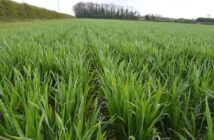This season it is all to play for – across the countryside winter wheat crops are looking good, with promising yield potential. However, with plenty of disease inoculum being reported, a robust spray at a robust rate will be needed at the critical T1 timing.
Richard Alcock, independent agronomist, responsible for 4000ha of winter wheat in the south west of England, said: “Crops are slightly more advanced than usual, perhaps a week to 10 days ahead with more advanced disease levels too.
“There is a lot of Septoria about and it is moving fast. Mild wet weather in the last six weeks has helped this and in my view we definitely can’t afford not to use an SDHI at T1 this year. I have used Adexar for the last couple of years and it is looking like I will be using it again this year.”
Bill Clark, technical director, NIAB said: “As well as Septoria, yellow rust is certainly around too. It is not as bad as it was last year, but it has been reported on probably half a dozen varieties up and down the country, not just on the east coast.
“In most seasons, Septoria is going to be your number one target at T1. However, on the east coast, if people are still growing susceptible varieties then in some years yellow rust could be potentially more serious than Septoria.
“In the last few years the biggest responses to fungicides we have seen have been on yellow rust susceptible varieties. When yellow rust is bad, yield losses are higher than they are to
Septoria.”
Ben Freer, business development manager, BASF, said: “It is crucial that growers use the best available chemistry at T1 to fight established infection and to protect leaf 3 in order to manage later infection up the plant.
“Whether Septoria or yellow rust is your main concern, Adexar is the ideal choice at T1 because whatever the season throws up it will deal with. Using Adexar at T1 gives resilience to the whole spray programme.
“Adexar, which is based on the leading SDHI (Xemium) and the strongest rust and Septoria azole (epoxiconazole), is fast, long acting and highly curative which is what you need for T1 because almost inevitably your leaf will be infected when you apply your fungicide.”
Applying Adexar made good economic sense at this timing, he added. Its quick action and continuous delivery of Xemium over time, from depots in the waxy layer of the leaf, ensured long lasting protection to T2, allowing undisturbed plant growth to generate more yield, consistently delivering the greatest margin of any fungicide.
Mr Clark added: “Growers should keep an eye on second wheats this year as last year we had quite a high incidence of tan spot which is a stubble-borne disease. Although you would never use Adexar specifically for tan spot, whilst you are using it for Septoria and yellow rust it will also give moderate control of this disease.”
In line with FRAG-UK guidelines for resistance management, BASF advocates the addition of a multi-site, like chlorothalonil, at T1. Mr Freer said: “We are very happy to add chlorothalonil to Adexar, it mixes well; there isn’t the antagonism that is seen with Aviator and chlorothalonil. Chlorothalonil gives added protection from disease and protects the fungicides from resistance development.”
Mr Clark concluded: “Getting the spray timing right at T1 is all about leaf emergence, looking for that final leaf 3. The danger is that people look at their crops and they look tall but they are not actually at the T1 timing. Spraying too early is just as bad as spraying too late at T1.”




